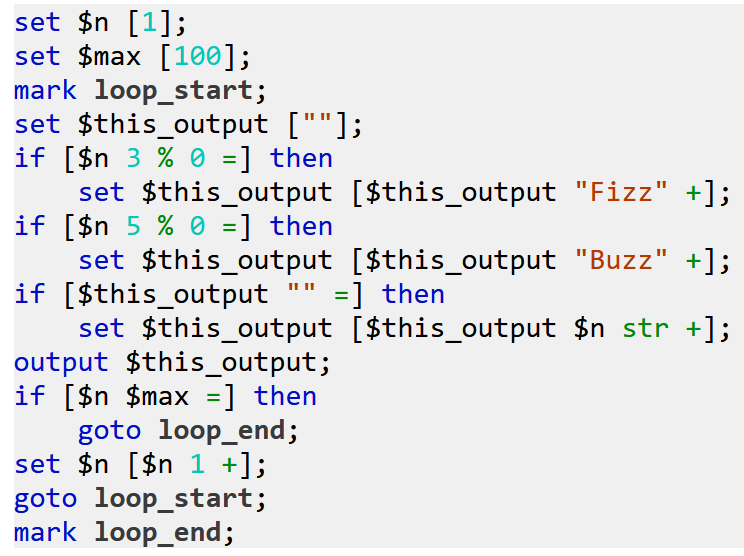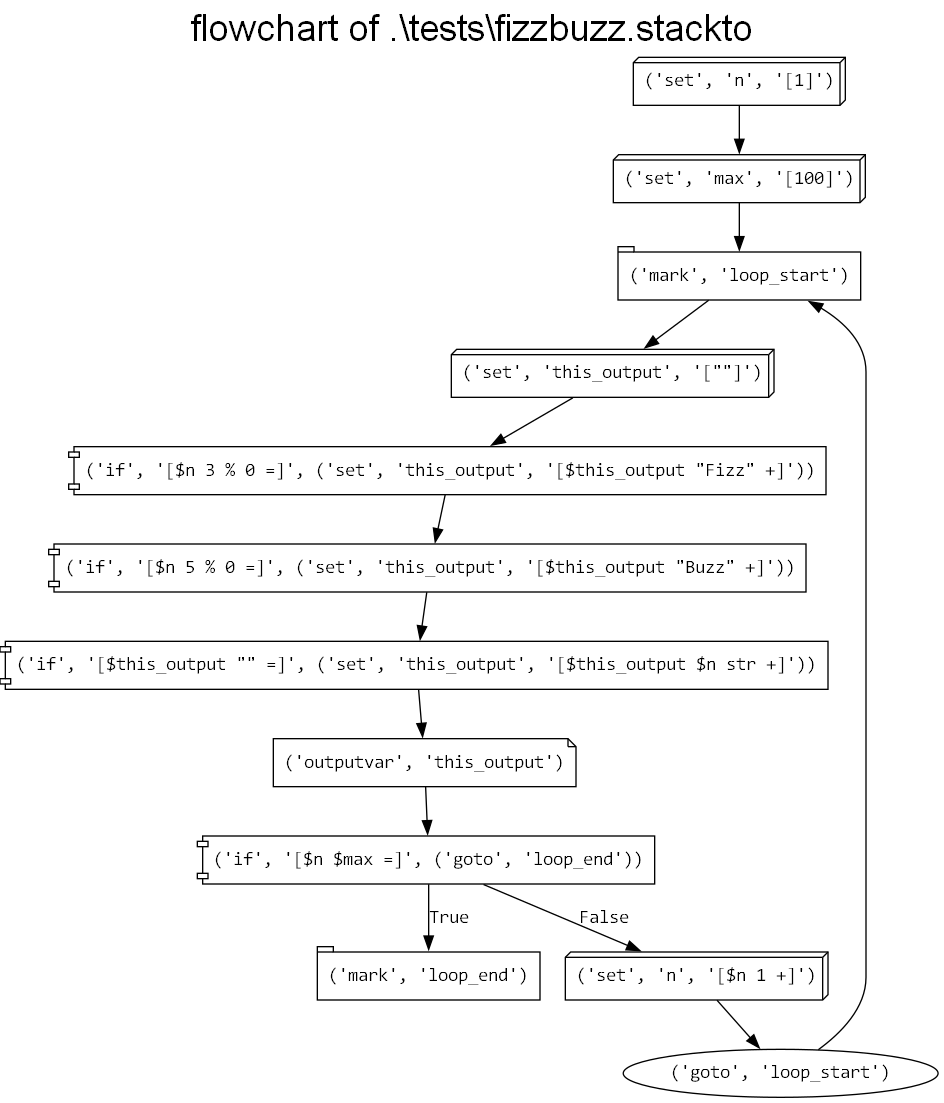stackto
StackTo
StackTo is a programming language that uses GOTO statements for control flow and RPN (with some additional QOL operators) for expression evaluation.
Examples
Hello world
output ['Hello, world!'];
FizzBuzz
set $n [1];
set $max [100];
mark loop_start;
set $this_output [""];
if [$n 3 % 0 =] then
set $this_output [$this_output "Fizz" +];
if [$n 5 % 0 =] then
set $this_output [$this_output "Buzz" +];
if [$this_output "" =] then
set $this_output [$this_output $n str +];
output $this_output;
if [$n $max =] then
goto loop_end;
set $n [$n 1 +];
goto loop_start;
mark loop_end;
Generate a list containing the first n primes
output ["Enter a number of primes to generate:"];
set $n input;
set $n [$n num];
output ["Generating a list of the first " $n str + " primes..." +];
set $i [2];
set $prime_list [0 \];
mark loop_start;
# determine whether $i is prime
set $j [2];
mark inner_loop_start;
set $is_prime [true];
if [$j $i 2 / >] then
goto inner_loop_end;
set $rem_zero [$i $j % 0 = !];
if [$rem_zero] then
set $j [$j 1 +];
if [$rem_zero !] then
set $is_prime [false];
if [$rem_zero !] then
goto inner_loop_end;
goto inner_loop_start;
mark inner_loop_end;
if [$is_prime] then
output ["Found prime: " $i str +];
# $is_prime is true if $i is prime and false otherwise
if [$is_prime] then
set $prime_list [$prime_list $i :];
if [$prime_list # $n =] then
goto loop_end;
set $i [$i 1 +];
goto loop_start;
mark loop_end;
output ["First " $n str " primes: " $prime_list str + + +];
Syntax highlighting
Syntax-highlighted HTML files of StackTo code can be generated by running highlight.py:
python highlight.py /path/to/file.stackto [-o OUTFILE] [-s]
usage: highlight.py [-h] [-o OUTFILE] [-s] infile
Generate a syntax-highlighted HTML file for a StackTo program.
positional arguments:
infile StackTo file to read from
optional arguments:
-h, --help show this help message and exit
-o OUTFILE, --outfile OUTFILE
HTML file to write to
-s, --standalone Whether to generate a standalone HTML file as opposed to a fragment
Example output (FizzBuzz):

More examples of HTML files can be seen in examples/highlighted.
Flowcharts
Because of StackTo’s simple control flow structure, it’s easy to generate a flowchart of a given StackTo program.
Example:

You can check out more flowchart examples in examples/flowcharts.
Flowcharts can be generated by running generate_flowchart.py, which uses the Graphviz Python library:
python generate_flowchart.py /path/to/file.stackto [-o OUTFILE]
usage: generate_flowchart.py [-h] [-o OUTFILE] infile
Generate a flowchart PNG for a StackTo program using Graphviz.
positional arguments:
infile StackTo file to read from
optional arguments:
-h, --help show this help message and exit
-o OUTFILE, --outfile OUTFILE
Graphviz/PNG filename to write to
Note that due to a Graphviz limitation, colon characters (:) are displayed as two periods (..) in the generated flowcharts.
Usage
Requirements
The StackTo interpreter is written in Python, so you will need Python installed to use it.
To generate flowcharts, you will need to install the Graphviz Python library if you don’t have it already:
python -m pip install graphviz
Interface
To run a StackTo program, put interpreter.py in your current directory and run the following command in the terminal:
python interpreter.py /path/to/file.stackto
usage: interpreter.py [-h] infile
Interpret a StackTo program.
positional arguments:
infile StackTo file to read from
optional arguments:
-h, --help show this help message and exit
Grammar
StackTo’s grammar is pretty simple. See grammar.md.
Evaluation pseudocode
Evaluating a StackTo program is also rather simple. See evaluation_pseudocode.md for a general idea of how programs are evaluated, statement by statement.
TODO list
The initial version of this language was put together in a weekend, so there are lots of things that remain to be done.
See TODO.md for a general idea of features and improvements that may eventually make their way into the language.